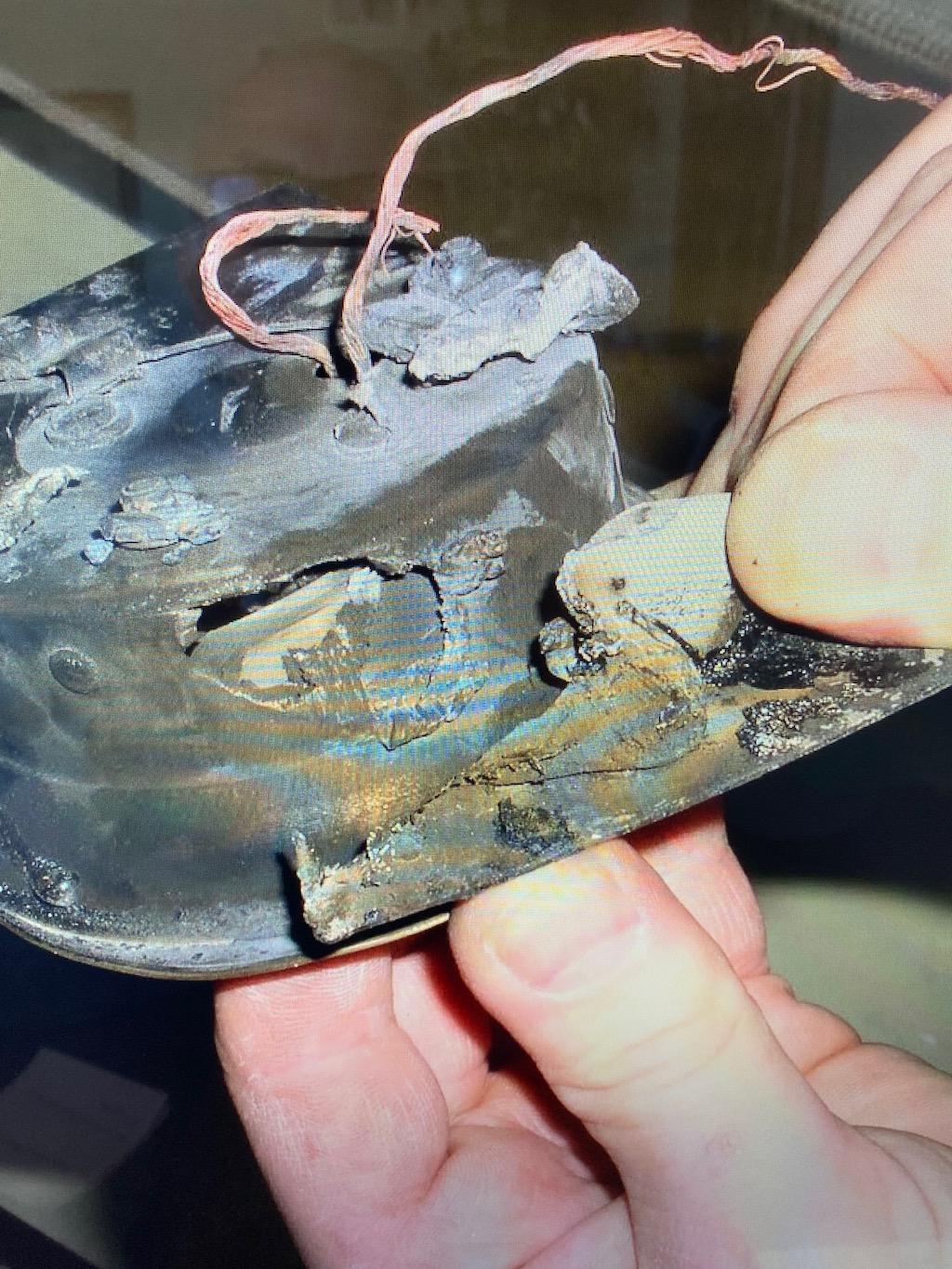
The hole in the cabin light fixture that was "welded" there by the electric current. The other end of the current was the oxygen line.
Again, with an engine fire, there is a light that comes on to tell you which engine is on fire. There is no doubt where to go and what to do. In this case—as I interpret the findings—the generators were discovered to be coming offline because there was a difference in the power they were putting into the system. Instead of shutting just one of them off, the current difference caused the system to take them both offline. There was no light that alerted the pilot to a dual alternator failure, synch or some such warning. There was evidently no follow-up procedure that suggested that the pilot try a series of tests to identify the good alternator. They just lit up their lights and said, “We’re outta here.” And since the problem occurred at low altitude and on final approach, the crew had an operating airplane and the runway in sight.
I remember a similar situation as we readied a C-5 for departure downrange (Saudi) out of Rhein-Mein AB during Operation Desert Shield. When power was applied to the radar, the display blossomed and then went out. Nothing else happened after that.
The maintenance tech then came into the cockpit and said: “No problem, sir. I’ve got another one in the truck.”
I could see that he was running a “Cockpit Display Unit Failed” checklist. The electrical troubleshooting procedure for this particular problem was to first replace the cockpit unit. A tech brought the new unit up and plugged it in. As soon as there was power on the unit, it got very bright, then very dim and then failed.
Up the ladder comes the third unit. As soon as that one was plugged in and power was brought online, the same blossoming and fading of light in the unit was noticed.
“Get another unit.”
The old line chief, who was watching this drama, chimed in: “Maybe we ought to think about this just a bit. We’re going to go through the entire spares shelf if we keep this up. Something has to be wrong besides the cockpit display unit.”
As we needed to have a radar and did not have time to troubleshoot the system, we shut down, got another airplane and flew the mission. About 20 hr. later, when we got back to Germany, the original ship was gone. We knew they would not have gone into the downrange weather without a functioning radar, so assumed there was something else that was wrong other than “Cockpit Display Unit Failed,” and they found it.
Here is a scary one. My friend was the check airman, in the jump seat, on this one.
Closet Light
On Nov. 18, 2003, at 1700 Eastern Standard Time, a corporate jet received minor damage from an in-flight fire during climb-out from the Bradley International Airport (BDL), Windsor Locks, Connecticut. The two certificated airline transport pilots and three passengers (four were pilots and another flight department employee) were not injured. Night visual meteorological conditions prevailed, and an instrument flight rules flight plan was filed for Westchester County Airport (HPN), White Plains, New York. The company training flight was conducted under 14 CFR Part 91.
According to the pilots, shortly after takeoff from runway 33 at BDL, at 500-600 ft. AGL, the check airman who was sitting in the jump seat informed the crew that there was "smoke in the cabin." The first officer advised air traffic control (ATC) of the situation, and declared an emergency, as the captain initiated a left turn to return to runway 33.
A cabin passenger, who was also a company pilot, reported that shortly after takeoff he smelled an odor of "electrical smoke," coming from the left side [aux] galley area, and then noticed a large amount of smoke pouring out of the drinking glass storage area located at the top of the [aux] galley. He announced to the cockpit crew, "we have a fire," and immediately turned off all galley power and pulled all circuit breakers on the galley power panel. This was an excellent move and, in many circumstances, would’ve been the end of the emergency. They had no idea what was causing the fire, but all the power that could support it was turned off.
The smoke seemed to subside for several seconds and then began to "pour out with force." The passenger then noticed bright, white burning particles and smoke being expelled from the coat closet and galley on the opposite side of the cabin, followed by a "stream of flames." He discharged the cabin fire extinguisher into the coat closet until it was empty, yelled, and then he and the additional passenger moved toward the right wing exit in preparation for landing. After the airplane came to a stop on the runway, the passengers evacuated from the right over wing exit.
Crash fire rescue then arrived and attempted to extinguish the fire in the overhead paneling of a coat closet, which was located directly behind the cockpit. Each time the fire was beat down, it would flare again. Finally, realizing, the fire was being fed by oxygen fire fighters broke into the air stair door and disabled the system. There is still some confusion as to whether this stopped the fire or the oxygen just ran out.
During the course of the investigation, the manufacturer issued a Service Bulletin to all operators, which recommended that the aircraft be inspected for any indication of interference between the closet light fixture or its wiring and the surrounding structure or equipment, particularly oxygen lines.
One additional same type aircraft was identified as needing a clamp to improve the oxygen line attachment. No interference between wiring and oxygen lines was noted in any of the other inspected aircraft.
The first part of this feature deals with confronting electrical fires and warnings given to pilots.






